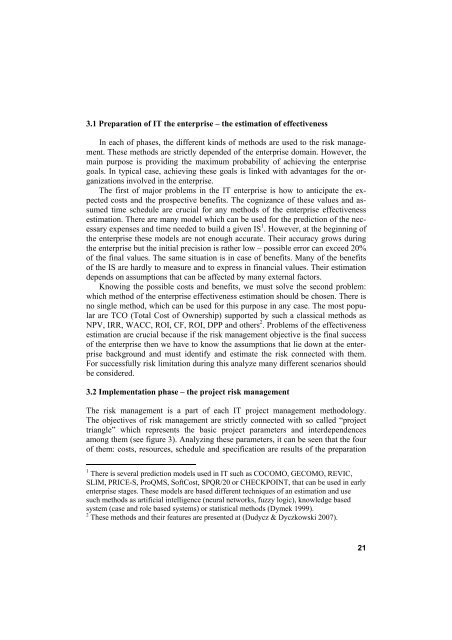INFORMATION SYSTEMS IN MANAGEMENT V - SGGW
INFORMATION SYSTEMS IN MANAGEMENT V - SGGW
INFORMATION SYSTEMS IN MANAGEMENT V - SGGW
Create successful ePaper yourself
Turn your PDF publications into a flip-book with our unique Google optimized e-Paper software.
3.1 Preparation of IT the enterprise – the estimation of effectiveness<br />
In each of phases, the different kinds of methods are used to the risk management.<br />
These methods are strictly depended of the enterprise domain. However, the<br />
main purpose is providing the maximum probability of achieving the enterprise<br />
goals. In typical case, achieving these goals is linked with advantages for the organizations<br />
involved in the enterprise.<br />
The first of major problems in the IT enterprise is how to anticipate the expected<br />
costs and the prospective benefits. The cognizance of these values and assumed<br />
time schedule are crucial for any methods of the enterprise effectiveness<br />
estimation. There are many model which can be used for the prediction of the necessary<br />
expenses and time needed to build a given IS 1 . However, at the beginning of<br />
the enterprise these models are not enough accurate. Their accuracy grows during<br />
the enterprise but the initial precision is rather low – possible error can exceed 20%<br />
of the final values. The same situation is in case of benefits. Many of the benefits<br />
of the IS are hardly to measure and to express in financial values. Their estimation<br />
depends on assumptions that can be affected by many external factors.<br />
Knowing the possible costs and benefits, we must solve the second problem:<br />
which method of the enterprise effectiveness estimation should be chosen. There is<br />
no single method, which can be used for this purpose in any case. The most popular<br />
are TCO (Total Cost of Ownership) supported by such a classical methods as<br />
NPV, IRR, WACC, ROI, CF, ROI, DPP and others 2 . Problems of the effectiveness<br />
estimation are crucial because if the risk management objective is the final success<br />
of the enterprise then we have to know the assumptions that lie down at the enterprise<br />
background and must identify and estimate the risk connected with them.<br />
For successfully risk limitation during this analyze many different scenarios should<br />
be considered.<br />
3.2 Implementation phase – the project risk management<br />
The risk management is a part of each IT project management methodology.<br />
The objectives of risk management are strictly connected with so called “project<br />
triangle” which represents the basic project parameters and interdependences<br />
among them (see figure 3). Analyzing these parameters, it can be seen that the four<br />
of them: costs, resources, schedule and specification are results of the preparation<br />
1 There is several prediction models used in IT such as COCOMO, GECOMO, REVIC,<br />
SLIM, PRICE-S, ProQMS, SoftCost, SPQR/20 or CHECKPO<strong>IN</strong>T, that can be used in early<br />
enterprise stages. These models are based different techniques of an estimation and use<br />
such methods as artificial intelligence (neural networks, fuzzy logic), knowledge based<br />
system (case and role based systems) or statistical methods (Dymek 1999).<br />
2 These methods and their features are presented at (Dudycz & Dyczkowski 2007).<br />
21


